

By
Don and Linda Freedman
Search TheTravelzine
TheTravelzine Group
Access Your Mail
Don's Gallery
Packing Hints
Planning Tips
Cities Links
Links
LINKS TO OUR TRAVELOGUES
Argentina, Buenos Aires - Jan-Mar 2010
Argentina, Buenos Aires - Jan-Mar 2009
Argentina, Buenos Aires - Jan-Mar 2008
Austria - Fall 2005
Belgium, Brussels - Fall 2000
Canada - Summer 2002
Canada - Summer 2001
Canada - Summer 2000
Czech Republic - Spring 2000
France - Fall 2002
France, Paris - Fall 2000
France, Paris - Spring 1999
France, Lyon - Spring 1999
Germany, Berlin - Fall 2009
Germany - Fall 2002
Germany - Spring 2000
Germany - Fall 1999
Greece - Fall 2012
Greece - Fall 1999
Greece - Fall 1997
Hungary - Spring 2000
Israel - Fall 1999
Italy - Winter 2007
Italy - Winter 2006
Italy - Winter 2005
Italy - Winter 2004
Italy - Winter 2003
Italy - Winter 2001
Italy - Fall 1998
Italy - Fall 1996
Netherlands - Spring 2000
Portugal, Azores - 2019
Portugal, Azores - 2018
Portugal, Sao Miguel & Lisbon - 2017
Portugal, Azores - 2017
Portugal, Azores - 2016
Portugal, Azores - 2015
Portugal, Azores - 2014
Portugal, Azores - 2013
Portugal, Azores - 2012
Portugal, Azores - 2011
Portugal, Lisbon - 2011
Portugal - Fall 2006
Portugal - Fall 2004
Portugal - Fall 2003
Portugal - Fall 2001
Portugal - Spring 1999
Portugal - Spring 1997
Slovakia - Spring 2000
Slovenia - Spring 1999
Slovenia - Fall 1996
Spain, Barcelona - Winter 2006
Switzerland - Fall 2002
Switzerland - Spring 2000
Switzerland - Spring 1999
Switzerland - Fall 1998
Switzerland - Fall 1997
Switzerland - Spring 1996
U.S. Florida, Key West - Fall 2006
U.S. Florida - Spring 2001
U.S. Maine - Summer 2002
U.S. Massachusetts - Summer 2003
U.S. Massachusetts - Summer 2002
U.S. Massachusetts - Summer 2001
U.S. New York State - Fall 2005
U.S. New York State - Summer 2004
U.S. New York State - Summer 2003
U.S. New York State - Summer 2001
U.S. Washington,DC - Spring 2000
ITALY
WINTER 2006
ROMA 1 | ROMA 2 | ROMA 3 | ROMA 4
FIRENZE | GENOVA | BOLOGNA
| RIMINI
BOLOGNA
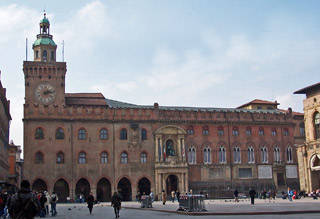 Bologna is located
due east of Genova in the region of Emilia Romagna which it shares with other fine cities,
such as Reggio Emilia, Parma, Modena, Ferrara and Rimini.
Due south of Venice, it is an easy stop on the way to
Florence. Now that you know where Bologna is, perhaps
what follows will entice you to visit.
Bologna is located
due east of Genova in the region of Emilia Romagna which it shares with other fine cities,
such as Reggio Emilia, Parma, Modena, Ferrara and Rimini.
Due south of Venice, it is an easy stop on the way to
Florence. Now that you know where Bologna is, perhaps
what follows will entice you to visit.
The train station borders Piazza Medaglie d'Oro from which you can get buses to any part of the city. We hadn't been to Bologna for many years so we opted to walk to refresh our memories.
Piazza XX Settembre led us through the ancient Porta Galliera to Via dell Indipendenza, the long arcaded shopping boulevard that runs through the ancient city center. Speaking of arcades, there are approximately 40 kilometers of these covered walkways throughout the city.
A few steps along is the pretty Parco della Montagnola and Piazza Otto Agosto where we remembered attending the market on a Friday on our last visit. At the market (called Piazzola, held every Friday and Saturday), you can find the usual array of household, clothing, jewelry, antiques, shoes, books and food products. At the same time there is a resale clothing market in the park. Just bring cash and bargaining skills. As this was a weekday, there were just a few vendors selling jewelry, antiques and books.
Within minutes we were greeted by the annual carnevale parade with floats, music, costumes and happy children with colorful make-up, a fun way to begin our visit.
Via Indipendenza ends at Pizza
Maggiore and Piazza Nettuna, the twin squares which form
the heart of the city. Bologna is the seat of the oldest
university in the world, founded in 1088. Bologna has
acquired many nicknames, the most important of which is
"Bologna la dotta" (Bologna the learned). The
rainbow of people on the sidewalks and in the squares are
students from around the world. Bologna is also an
important commercial city, which hosts a multitude of
trade fairs, exhibitions and conventions so amongst the
crowds of students were smartly dressed business people.
Universities and businesses create innovation and a
tradition of culture and art; so it is in Bologna. 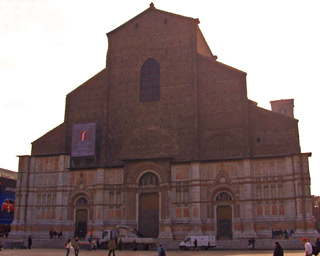
Entering the twin piazzas it became
obvious how the city acquired another nickname, "Bologna
la rossa" (Bologna the red), from the rosy color of
the medieval buildings. It is also said that it came
about from its left-leaning politics. The wide open space
of Maggiore and Nettuno is delineated by majestic palazzi
and the Basilica of San Petronio. We were tempted to roll
our suitcases over to the church steps for a bit of
admiration time but since it was getting late and our
hotel was just around the corner we decided to check in
and get settled.
[Back
to Top]
Hotel Orologio, next to Piazza Maggiore on Via IV Novembre, 10, is one of four Bologna Art Hotels conveniently located in the city center. An "art" hotel it is - intimate, charming and cozy. A caring staff cheerfully looked after all our needs and made our stay as comfortable as possible. Our twin-bedded room was a haven of both modern and old world comfort done in coordinated floral green with lovely antique pieces. The good size bathroom was well-stocked with thoughtful, quality amenities. Best of all was the excellent lighting - finally a good shave!
Breakfast the next morning was
superb, starting from the freshly-squeezed blood orange
juice. Now it was decision-making time; we could not
possibly indulge in all the beautifully presented quality
offerings. It was yes to the glorious bocconcini with
ripe tomato slices and grainy bread. The fresh fruit
salad was also a must and it was with great reluctance
that we passed on the inviting meats, other cheeses,
sweets, plus, plus.
[Back
to Top]
Via de Carbonesi is due south of the hotel and at #8 is Cesari, where we found fine food at comfortable prices pleasantly complimented by a cheerful owner and staff. Dark wood paneled walls, matching tables and chairs, wine bottles and subdued lighting create a pleasant dining atmosphere. It was a good thing we had the hotel make reservations as every table was soon occupied.
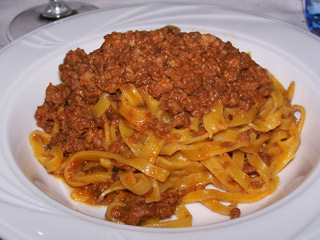 The menu sang with
a chorus of regional specialties. It is not usual for
Linda to sing the praises of a mixed salad, but one of
exceptionally flavorful vegetables combined with old
balsamic, quality olive oil, laced with Parmigiano
Reggiano was worth a few notes. She followed up with
tagliatelle alla bolognese and was delighted with the
rich meat ragù and al dente noodles.
The menu sang with
a chorus of regional specialties. It is not usual for
Linda to sing the praises of a mixed salad, but one of
exceptionally flavorful vegetables combined with old
balsamic, quality olive oil, laced with Parmigiano
Reggiano was worth a few notes. She followed up with
tagliatelle alla bolognese and was delighted with the
rich meat ragù and al dente noodles.
My ravioli, liberally filled with pumpkin and dressed in butter and Parmigiano was a heavenly starter. I was delighted to find coniglo in agrodolce con capperi, olive and cipollina (rabbit stewed in a sweet and sour sauce with capers, olives and onions), a regional specialty I discovered years ago. Plump tender morsels in the tangy sauce accompanied by polenta, another regional favorite, hit a high note for me.
A medium dry Sangiovese red was a perfect match for the meal. Thankfully the bread basket, perhaps the best we had this trip, was replenished as necessary.
Somehow we had room for dolci; a ricotta cheese and almond tart with a touch of chocolate sounded the final note. Of course we could not reject the house offered ice cold blueberry grappa.
Oh yes, another nickname for Bologna is "La Grassa" (The Fat), which comes from the fact that Bolognese take their eating very seriously. I guess Linda and I have some Bolognese genes (would you believe tight jeans!).
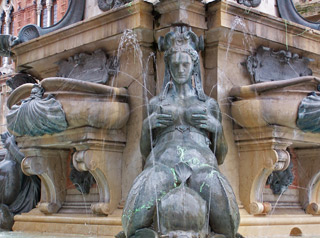 On the way back to
the hotel we saw the bronze Fontana del Nettuno, in
Piazza Nettuno, aglow in the evening darkness. Linda
broke out her digital and captured Neptune grasping his
trident while crushing a fish beneath his foot while four
cherubs are blowing water through their pipes and four
well-endowed mermaids are spouting their own water.
On the way back to
the hotel we saw the bronze Fontana del Nettuno, in
Piazza Nettuno, aglow in the evening darkness. Linda
broke out her digital and captured Neptune grasping his
trident while crushing a fish beneath his foot while four
cherubs are blowing water through their pipes and four
well-endowed mermaids are spouting their own water.
[Back
to Top]
Basilica di San Petronio, named after the city's patron saint, is the largest church in Bologna and the fifth largest in the world. Construction was started in 1392 and planned to be larger than St. Peter's in Roma. The Vatican would not allow this to happen and work came to halt. It is still a monumental work, albeit with an unfinished façade, which makes it quite unique as it dominates Piazza Maggiore. The bottom half of the façade of stone and red marble moldings is quite lovely and in complete contrast with the unfinished brick of the upper part. The central doorway has carvings depicting scenes from the Old and New Testament and a lovely Madonna and Child.
We were struck by the brightness inside, the result of its south-facing orientation. Look for the solar clock, which indicates the time of day. The sun’s rays shining through a small hole in the ceiling strike the brass meridian built into the floor of the north aisle. There is a distinct line indicating the noon hour. Another line has a box with a circle indicating the summer solstice and at the end of the line is the winter solstice box.
On a side altar next to the Patron
Saint is a fresco depicting Mohammad which created
confusion and controversy and at the time brought
notoriety to the church. The eleven chapels, decorated
with beautiful frescoes, contain the tombs of prominent
citizens. The Coat of Arms of Bologna is painted behind
the main altar. 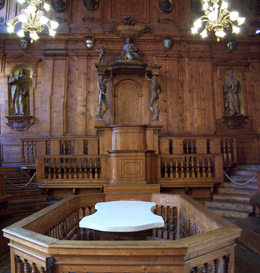
Just behind San Petronio is the 16th
century Palazzo Archiginnasio, the ancient seat of the
university. The frescoed and sculptured entry and
courtyard lead to what is now the largest municipal
library in Italy, containing 600,000 to 700,000 books
many of which are rare editions. While admission to the
library is limited, visitors are permitted in the "Teatro
Anatomico". Wood paneled walls, statues of famous
physicians and wooden benches surround a single table in
the center of the operating theater. The ceiling is
painted with the constellations. The "Grand Room"
is covered with coats-of-arms and the imposing "Great
Room" is the general meeting room for law students.
[Back
to Top]
There is a wonderful view of the Piazza Maggiore from the windows of the Palazzo del Comune (town hall) cafeteria. The Palazzo, with the Museo Morandi and Municipal Art Collections on the 2nd floor, was built between the 13th and 14th centuries. There is a magnificent carillon clock in its 1444 bell tower.
Diagonally across from the town
hall is the Palazzo Re Enzo which was built between 1244
and 1246 as the town hall. It was here that King Enzo was
kept prisoner for thirty years until he died in 1272.
Next to the Basilica is the Palazzo dei Banchi, the first
of the Pavaglione, a long line of buildings whose
porticos connect the square to Palazzo dell Archiginnasio,
a favorite gathering place of the Bolognesi. 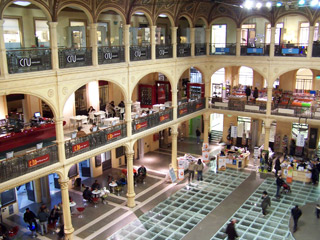
The Sala Borsa, old stock exchange,
in Piazza Nettuno is a splendid old building that has
been transformed into a stupendous multimedia library.
The grand open interior is surrounded by balconies filled
with thousands of DVDs, CDs and books of all description.
With free internet access, multimedia terminals,
restaurants, cafes, a wine bar and a cafeteria, it is a
haven for university students. Excavated Roman ruins can
be seen beneath a glass floor at ground level.
[Back
to Top]
Piazza Maggiore is the living heart of the city where people come to pray, conduct civic business, shop, eat and meet. It is a crossroads with a constant flow of people going from one part of the city to another. This is the ultimate place for year-round people watching.
We wandered into the maze of old
streets east of Maggiore starting on Via Clavature where
we drawn into the church of Santa Maria della Vita. It
was quite a contrast going from the hustle and bustle of
a busy shopping street into the peaceful quiet of a small
church. Though small its height and elegant design are
special. It is famous as the home of Nicolò dell' Arca's
"Pieta" a masterpiece of Italian sculpture
known as "Compianto su Cristo Morto", 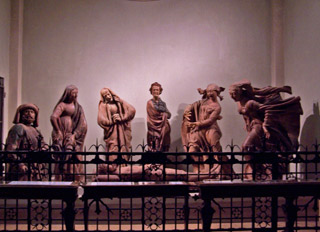 Mourning over the
Dead Christ, also described as "The Stone Crying"
or “Scream in Stone". It is a fascinating
terracotta work of art.
Mourning over the
Dead Christ, also described as "The Stone Crying"
or “Scream in Stone". It is a fascinating
terracotta work of art.
These medieval streets are filled
with markets, food shops, bakeries, pastry shops,
restaurants, cafes and bars. We turned onto Via Drappiere
to find "Girberto" selling high quality foods
and wine since 1905, and the mouthwatering bakery
Paoloatti. At the corner at Via Capararie, #1 is the well
known Tamburini Deli, which offers an appetizing
assortment of meats, cheeses and prepared foods.
Tamburini also features a tavola calda. We took our cue
from the long lineup of locals, grabbed a tray and waited
our turn. We had half portions of grilled pork with fries,
lasagna, rice with treviso radiccio, and cauliflower and
leek baked with cheese. The food certainly could have
been hotter and the pork was tough so, basically, not
worth a detour.
[Back
to Top]
Via Rizzoli leads to Piazza di Porta Ravegnana, home of Bologna's landmark "Le Due Torri" (Two Towers). In the twelfth and thirteenth centuries, every noble family wanted its tower to outdo everyone else’s. These two are the most famous of the few that have survived. The taller (and still straight) one of two, La Torre degli Asinelli, about 98 meters high, has 498 internal oak steps twisting to the top for great views. The more exciting one is the leaning Torre Garisenda, which was cut down from its original 77 meters to 48, in an attempt to keep it from falling. When you see it, you are convinced it will tumble down before your eyes. It is a fascinating architectural display.
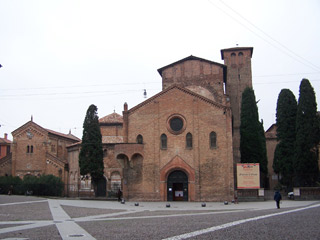 Piazza di Porta Ravegnana is a hub with
interesting streets darting out like spokes in every
direction. We chose Via San Stefano which leads to
Basilica di Santo Stefano beautifully situated in the
Piazza of the same name. This is an eclectic complex of
churches, chapels, courtyards, cloisters and crypts of
various ages starting from the fifth century. The
original Seven Churches are now four.
Piazza di Porta Ravegnana is a hub with
interesting streets darting out like spokes in every
direction. We chose Via San Stefano which leads to
Basilica di Santo Stefano beautifully situated in the
Piazza of the same name. This is an eclectic complex of
churches, chapels, courtyards, cloisters and crypts of
various ages starting from the fifth century. The
original Seven Churches are now four.
San Vitale e Agricola is the city's oldest, with an attractive brick and stone altar and two engraved sarcophagi. The octagonal Church of Holy Soporta has brick walls, marble columns and a very high center stone altar. Chiese del Santissimo Crocifisso has a crypt with an inscription dedicated to the Roman goddess Isis that houses the bones of St. Petronius. Chiese della Santa Trinita's gracious cloister has a lovely, arcaded loggia on two levels. A Benedictine Monastery is part of the complex as well as a museum with a modest collection of frescoes and paintings.
Across the way from the complex we
entered the Corte Isolani, a shopping gallery formed by a
series of inner courtyards of Isolani family residences.
The shops, cafes and restaurants looked very inviting.
[Back
to Top]
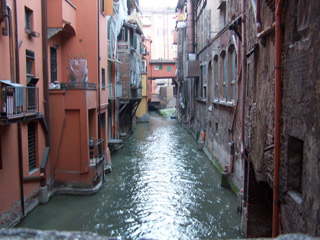 On our way to
dinner on Via Della Belle Arti we stopped on Via Piella
to see the canals that flow through the foundations of
the city. Bologna was not built on a river so in order to
provide water for drinking and sanitation, canals were
built from the Reno river in the west. In time streets
were built over the canals and there are only a few spots
where they are visible, one those being from the bridge
on Via Piella.
On our way to
dinner on Via Della Belle Arti we stopped on Via Piella
to see the canals that flow through the foundations of
the city. Bologna was not built on a river so in order to
provide water for drinking and sanitation, canals were
built from the Reno river in the west. In time streets
were built over the canals and there are only a few spots
where they are visible, one those being from the bridge
on Via Piella.
Via Della Belle Arti houses La Pinacoteca Nazionale (National Art Gallery) and the adjoining Accademia delle Belle Arti. The Gallery was founded by Napoleon for the art collection he had confiscated from churches and monasteries. Today it contains one of the largest collections of European art from the thirteenth and fourteenth centuries. The varied restaurants, cafes, bars and shops create a bohemian ambiance in the area.
The walls at Trattoria Anna Maria at #17a Via belle Arti, tel. 051 266894, are filled with photos of famous people and customer testimonials. Our tagliatelle al ragu and tortellini al gorgonzola were excellent, but we found the portions too small. The stinco was roasted properly and very good. The house red wine was light and fruity and the homemade lemon sorbet was a perfect finish.
After breakfast we were back to
Piazza di Porta Ravegna to investigate another street.
There are numerous university facilities throughout the
city but Via Zamboni is the principle university street,
with an army of students always on the move between the
various faculties in the area. The Musei di Palazzo Poggi,
became the seat of the university in 1803 when it was
moved from Archiginnasio. Besides housing major museums
it contains the university library and many of the main
faculties. The range of museums covers diverse subject
matter; science, natural history, archeology, anatomy,
obstetrics (with life size wax figures), physics,
geography, navigation, military architecture, astrology,
etc.
[Back
to Top]
The area north of Piazza di Porta Ravegna bordered by Via G. Oberdan and Via Zamboni was home to the Jewish Ghetto. Via dei Giudei (street of the Jews) leads into a labyrinth of narrow streets that formed the ghetto. Via Dell' Inferno (hell street) runs north-south in the center of the area and there is a memorial stone at #16 to commemorate the ancient synagogue which was located on the top floor of the building. There is a multimedia Jewish Museum on Via Valdonica.
Before heading over to the present synagogue, we stopped for lunch at Drogheria della Rosa, via Cartoleria 10. Emanuele Addone, whose energy and love of life is contagious, greets the new arrivals like old friends. Luckily we had stopped by the day before because when we arrived there was just our reserved table waiting. Drogheria is an ancient pharmacy, pretty much in tact with the original wood counter (now a bar) and shelving for apothecary bottles, artifacts and now, wine bottles. The trattoria is charming and warm with a short menu of four primi, eight secondi and three dolci.
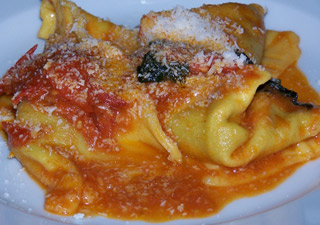 The house offers a
glass of delicious vino spumanti brut-prosecco Foss Marai
Cuvee and a platter of prosciutto, mortadella and
mozzarella di bufala. Emanuele gave us time to savor
these delights before he arrived to help us with our next
move. He patiently described the pastas, three of which
sounded tempting, so we ordered all three! This turned
out to be a fabulous decision - tortelli were filled with
local cheese and topped with artichoke sauce, triangoli
were stuffed with potato and lightly tossed in sage
butter and the ravioli were filled with eggplant and
topped with a fresh tomato and basil. Each one was
freshly house made, the deep pockets stuffed with
exquisite filling then partnered with sauce that made the
whole greater than the sum of its parts. This was pasta
perfection. A medium dry red Pinot Nero of the region was
excellent.
The house offers a
glass of delicious vino spumanti brut-prosecco Foss Marai
Cuvee and a platter of prosciutto, mortadella and
mozzarella di bufala. Emanuele gave us time to savor
these delights before he arrived to help us with our next
move. He patiently described the pastas, three of which
sounded tempting, so we ordered all three! This turned
out to be a fabulous decision - tortelli were filled with
local cheese and topped with artichoke sauce, triangoli
were stuffed with potato and lightly tossed in sage
butter and the ravioli were filled with eggplant and
topped with a fresh tomato and basil. Each one was
freshly house made, the deep pockets stuffed with
exquisite filling then partnered with sauce that made the
whole greater than the sum of its parts. This was pasta
perfection. A medium dry red Pinot Nero of the region was
excellent.
Linda exercised some willpower by choosing a marvelous vegetable plate consisting of a veggie mousse, endive, broccoli, green beans and fennel as her secondo. I needed some protein and was rewarded with a filetto al naturale o all'aceto balsamico di Modena, a rare filet with balsamic sauce served with fennel and endive.
We learned that everything was bursting with flavor because Emanuele goes to the market every day and changes the menu seasonally. Only the freshest available products find their way to his cucina.
On the way out we met a delightful
couple from Denmark who have a restaurant back home
called Tyven Kokken. They were touring Italy for ideas and were
having their second lunch at Drogheria. We joined them
for a while and shared travel experiences.
[Back
to Top]
The synagogue is on Via dei Gombruti, 9. We were not sure where it was until we saw a police car parked across the street from the entrance. It is a shame that full time police presence is necessary. This is actually not the main entrance to the synagogue but rather the entrance to the community center and the administrative offices but for security reasons, this is the entrance that is used.
We rang the bell to request a visit but the woman inside only spoke Italian. Fortunately for us Jay, a delightful and bright American Jewish guy who is studying at the university, showed up in the nick of time and graciously served as our translator and tour guide.
The following information is from
"The Synagogue of Bologna, the past, present and
future of a Jewish presence". "The Jewish
people have a long and proud history in Bologna. The
first prayer oratory after the expulsion Of the Jews from
the Papal States dates back to 1839. In 1868 services
temporarily took place in a room in a building on 17 Via
dei Gombruti. An adjoining building became available and
purchased by the Jewish Community. Work on a new Temple
started in 1874 and was completed in 1877 and dedicated
on the evening before vigil of Shavuot. A reconstruction
took place at the turn of the century and completed in l928,
which temple was razed during bombings in WWII. The
reconstruction of the present Synagogue was completed in
1953.” 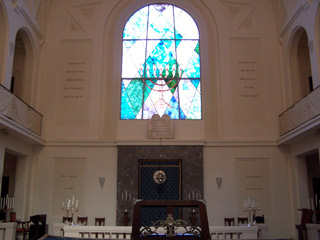
The large chapel has a vaulted ceiling and is bright and airy. Particularly striking is a large round window on the west wall with the panes forming the Star of David and at this time of day the sun’s rays were shining through illuminating the chapel. A seven-branched menorah (candelabrum), as in the ancient temple, is the design feature in the colorful stained glass window above the altar. The women’s galleries are on both sides of the upper floor. The congregation is orthodox and we were told that the Jewish community numbers 200-300.
Later in the evening, we stopped by
the casual wine bar Pane Vino e San Daniele, Via
Altabella 3a, tel. 051 2960540 for a light meal. The menu
features meats, cheeses, polenta, salads, grilled veggies
and soups. We had ribollita and a mixed salad with cooked
prosciutto and grano. We couldn't resist sharing a slice
of ricotta pie with pear, nuts and chocolate bits, which
we savored while discussing how much we enjoyed renewing
our acquaintance with Bologna.
[Back
to Top]
ROMA 1 | ROMA 2 | ROMA 3 | ROMA 4
FIRENZE | GENOVA | BOLOGNA
| RIMINI
Search TheTravelzine | TheTravelzine Group | Don's Gallery
Packing Hints | Planning
Tips | Cities
Links
All pages on TheTravelzine.com©Copyright 1996-2020 Don & Linda Freedman